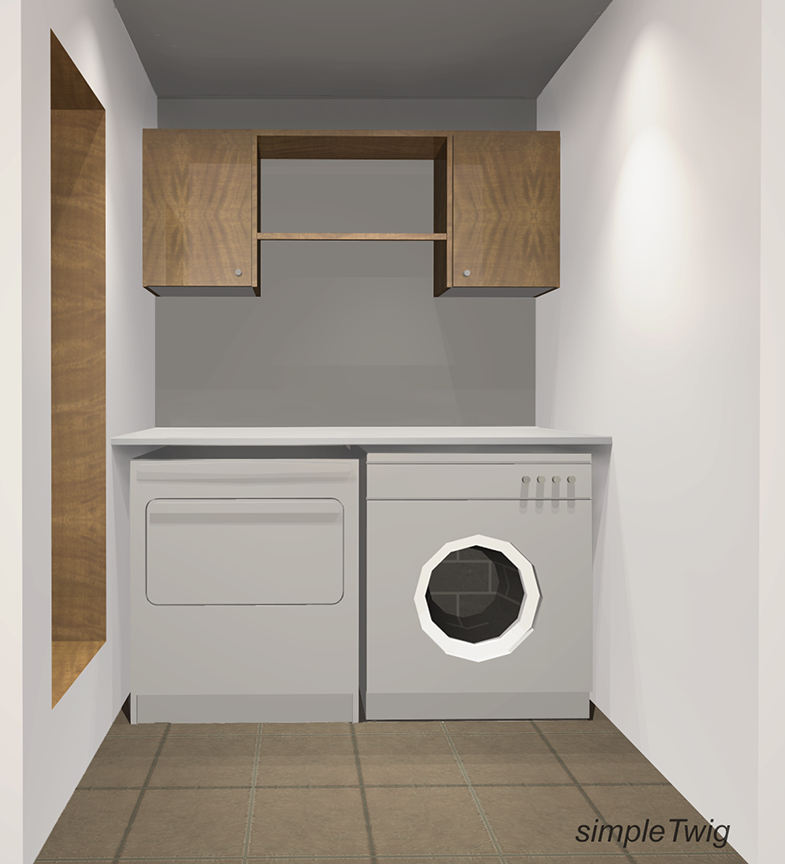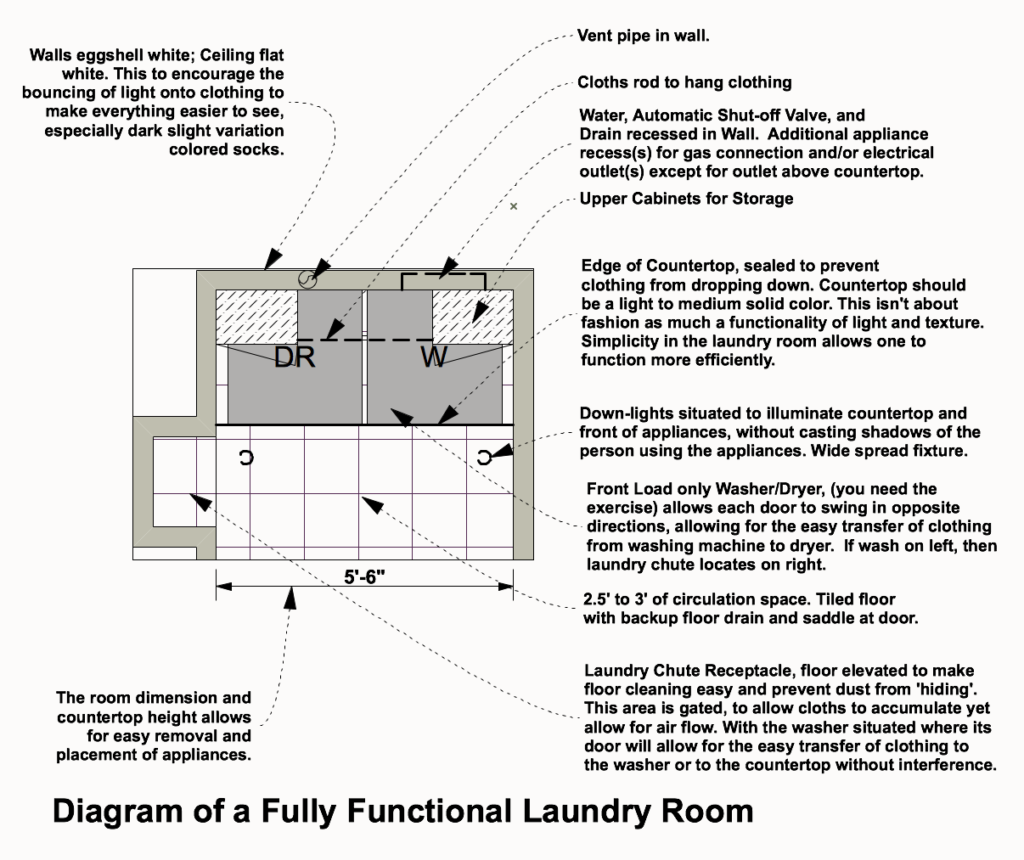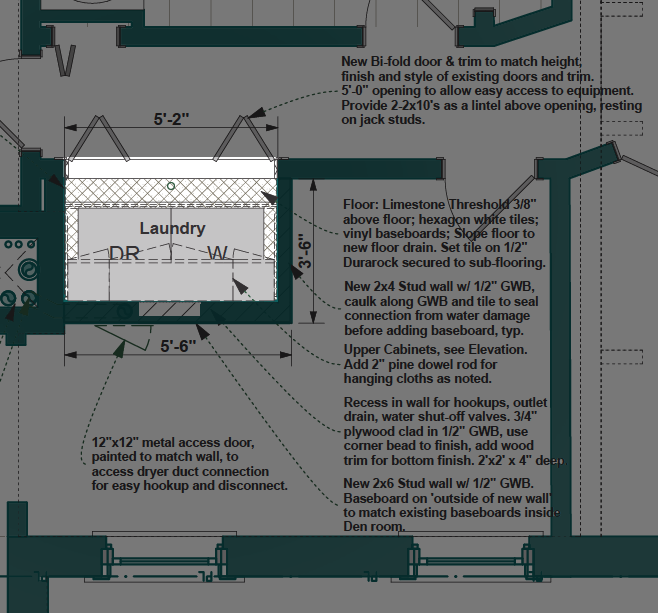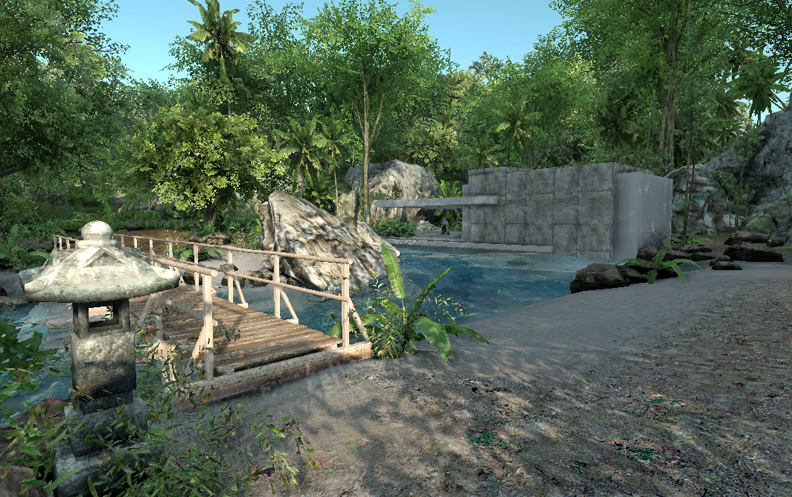It’s looming, consuming, it’s laundry day.
Homes are functional machines (not if you choose the wrong Architect), although most people don’t consider this factor when designing a new home, or only as a side note. Yet when choosing an Architect you hope, or assume, they know what they’re doing. The truth is there might be passing consideration at best, for some of your home’s most important functional aspects, like your closets, laundry and that whole messy process.
Lets, for a moment, discuss the functional aspects of what humans have to deal with when functioning in a home solely from their point of view, and assume there is a fitting design to solve their daily and weekly tasks in order to save humans the maximum amount of time, thus providing extended opportunities to enjoy life. It’s a house as machine for humans examination!
For this article, we focus on the Laundry Room, with touches of other aspects of home living. Laundry room types span the imagination, yet for most people they fall into three categories, the small closet, the expanded closet and the laundry room. Each type has its basic functional components, presented here with a SimpleTwig Architectural twist, that is, they are made to be the best they can. This is possible due to our extensive experience in home and dwelling design, including our own personal experience, to bring together the best approaches to making a truly functional room that will save people precious time in doing this little appreciated task. In this spirit, lets get the laundry done so we can have more time to live.
And boy have we seen the alternative setups for laundry, stuck in the corner of a dusty cellar, shoved into a closet where it is nearly impossible to close the door, and in these circumstances you know that a small percentage of clothing is lost to the cracks and crevasses around the machines, living out their lonely lives with whatever else might be lurking under there….
Lets face it, not designing the laundry to be ‘right’ is just stupid. It’s not like it cost a fortune to make it right, as it’s not in the middle of your living room. It takes little effort to put things in the right place and make both their maintenance a breeze while making their use easy peasy and efficient, because who really wants to hang out in a laundry room?
Good Morning, it’s Saturday once again;
And there it is, stacks of dirty laundry. If you have room and are smart, sorting starts at the laundry basket. Whites in one, colors in another, darks in the third and maybe those bleeding reds in yet another. This makes moving dirty laundry into the washing machine easier, assuming there isn’t any stain removal going on. In an ideal home there are chutes from the bathroom into baskets situated in the laundry room, thus preventing the need to carry smelly, sometimes fur covered clothing to its destination. In fact, pre-sorting is the first step at efficiency, that is at the moment one throws their dirty cloths into the basket, it goes into the correct basket. In this respect, coloring the basket the same colors as the cloths they should hold is an added advantage of preventing mixups.
Clothing, Closets & Laundry:
There is a need to put on cloths, take them off, change them for a variety of activities, wash them, and put them back into storage in pre-ready to wear shape. OMG is this boring to talk about or what? But at SimpleTwig yes this is the type of detail we consider when designing a project, so here it is…
Closets: There are shoes, socks, leg wear, torso wear, ties, belts, jackets, hats and in all varieties, all typically designed for different seasons. For the layout of a closet entity, one could arrange clothing from the lightest summer wear on the right moving towards the heaviest winter wear on the left. Between the heavy jackets one could place leg wear. This allows one to know where to focus when searching for something appropriate. Of course this could be split again between casual wear and formal/work wear clothing thus creating two sections each seasonally organized from right to left.
Shoes and Socks should be close to one another, with accommodations for sports, dress, sandals, casual or whatever other type, including winter/work boots.
Drawer space for socks.
Shelf space is important for hats.
Drawer space to store winter wear, until it is in use where it can be stored on a shelf.
Drawer space for undergarments.
Closets, if possible, should be walk-in with an ability to sit down. They should not be used for general storage unless in a separate part of the closet, that is the area reserved for clothing shall be in the same specific area unobstructed by any other personal item except clothing.
Laundry: The laundry room, if designed properly, is a place one will spend little time in. As shown there is a built in laundry chute so there’s no need to carry baskets or bump into walls, trip down stairs, or step on toys. Instead, walk into the laundry room, open the washing machine door, do a little separation on the countertop and get the machine running.
Appliances: As you can see, both machines are front loading allowing for a full countertop that prevents socks or other clothing items from getting lost (or running away). This also forces people to bend over which helps them physically (versus bending over a top loading machine to dig out all clothing from the bottom). Ignoring this type of activity will have ramifications later in life, so from our point of view it’s the way it should be, especially considering there is a 5′-6″ countertop which will make significant difference in this part of the residential machine.
Having both doors adjacent to one another makes transfer of wet cloths to the dryer easier. The washing machine and dryer should sit on rubber insulator pads to reduce structure vibration and noise.
All connections, whether electrical, gas and water (including automatic shut-off valves, hoses, drainage connections) shall be located in a recess within the wall. This is to ensure the appliances can be pushed all the way to the back wall. Further, venting shall be inside the wall and connected with the shortest possible tube to the dryer.
Countertop: As cloths dry, they can be folded and stacked on the countertop, and when ready for a trip to the closet be carried in a larger group to reduce the amount of trips.
Storage Cabinets: Above the counter are two cabinets for laundry supplies, supporting a cloths rod to allow for immediate hanging of t-shirts and the like, thus helping to prevent wrinkles.
Ironing: It is optional to add ironing to the laundry room, but we would suggest a much larger room with an optional television.
Lighting, color of walls, ceiling and floor are all factors as noted in the plan drawing. The laundry room should be dedicated to only laundry, leaving brooms, vacuums or other utility tools cleaning storage items located elsewhere in their own appropriate location.

Noise pollution: Laundry should not be in a bathroom or kitchen, or in the hallway, living room or some other place where noise and potentially vibration will become a disturbing nuisance to the residents. While laundry must be completed, its impact should be minimized.
Insulation: Because of airborne sound transmission, one should insulate all surrounding walls, floors and ceiling with acoustical insulation. Further, the door to the laundry room shall be weather stripped all around, to further dampen the transmission of sound. With all measures in place, noise should be reduced to a muffled background level.
Flooring: The floor shall be tile, with a small backup drain. The drain can be simple and smaller than a typical floor drain for a cellar, in that it will suffice in drainage if for any reason the automatic shutoff valve fails. This also brings up the hose, which shall be metal clad to prevent binding, puncture or breakage of the rubber hose within.

Location: While this scheme implies the laundry room is on a lower floor, this isn’t exactly ideal. Ideally the laundry room is located on the same level as the residences’ closets. This ensures the least amount of time to transfer clean cloths back to their storing location. Of course if the only location available is a cellar/basement, or if bedrooms exist on multiple levels, or there’s just one place to locate the laundry room, then all these and other factors will ultimately impact its location, clearly.
If one considered the best location, then factoring in rough-in plumbing and locations of bedrooms/closets, one would connect the laundry to the main bathroom, so that dirty laundry could be transfer through a slot/chute from the bathroom, and then be so close to the closets that transfer of clothing back to the closets would take little time. Serving 4 people with many loads per week, the ideal location and setup could shave a half hour off this monotonous chore.
Together, every component big and small helps the user complete their task in the shortest amount of time possible.
Basic Laundry Facility Closet:
While the ideal Laundry Room would be desired by most people, it’s not always achievable given space constraints. Especially in New York City where existing townhouses, existing plumbing runs or other constraints make it impossible to devote an entire room. In this case we suggest a closet solution which provides the core elements of the ideal plan but in a much smaller space.
The downside is noise, in that the doors to a closet facility usually are bi-fold and thus next to impossible to seal. This means noise will emanate when washing or drying into the rest of the house. This noise if further enhanced since most townhouse hallways are wood or another non-absorbent material which just bounces the noise around rather than soaking it up.

While noise is a factor when having a closet type laundry room, there are still benefits that make it a strong option, like convenience to bedrooms, a 5 foot wide countertop, cabinets and cloths rod, and essentially all the other features noted above including lighting, floor drain, a recessed niche for hookups, etc.
Multi-Function Laundry Room:
When space is even less available, one may need to choose a stackable washing machine and dryer. In this plan we do just that, but offer in this multi-use utility/laundry room a smaller countertop set on base cabinets, with additional wall cabinets to help with storage needs in this rental unit.

When space is tight, as it was in the 2 bedroom apartment project the final location of the laundry (for rental tenants having their own laundry is a huge benefit) has to become part of the background composition, that is, the main spaces must dominate the design in order to carve out the best space, the laundry being subservient. Yet here we align the laundry’s plumbing with that of the kitchen so it can use the same drain system. It should be noted that there are Sud-zone requirements that have to be met by code.
But one should not confuse the ability to squeeze stackable units into a dwelling with providing an ideal solution. While this might be great for renters, it is clearly not an ideal solution and a big compromise. Certainly not as big of a compromise as having to haul one’s dirty cloths to a laundry service, but it is still a compromise and will result in less efficient quality of life.
Ultimate Laundry Room Facility:
While I’d like to develop a plan and images for the purposes of this article, I’ll leave that for some special project. For now I’ll just describe a few of its elements. The ultimate laundry room probably comes with house keeping staff, but whether it does or not there are those functional components it will have. First, an island for folding and allowing multiple people to help with the process. On one side will be a step platform to allow kids to participate. There will be a permanent ironing board and station. Further, there will be a folding station that will assist in folding cloths perfectly every time. There will be carts to help carry hanging clothing back to the closets probably via a service elevator directly connected to the house keeping wing of the residence.
But one might ask, why is it important to make high-end laundry so efficient especially if one can afford staff? The simple truth is, it reduces the time it takes for them to accomplish this task allowing them to accomplish more within the home.
Of course dirty clothing comes to the laundry room directly from the sitting area within the bathrooms.
Conclusion:
We, us humans, like to focus our attention on those rooms which command our attention the most, the master suite, the living area and kitchen, with some attention to the bathroom(s). Yet it can be said that it is the functionality of rooms like the laundry and our closets that have the potential to save us valuable time so we can enjoy living life with fewer burdens and chores. It is in its most essential form, making a dwelling a well oiled functional machine for living, and harnessing the saved time to do those activities that make life more enjoyable.
